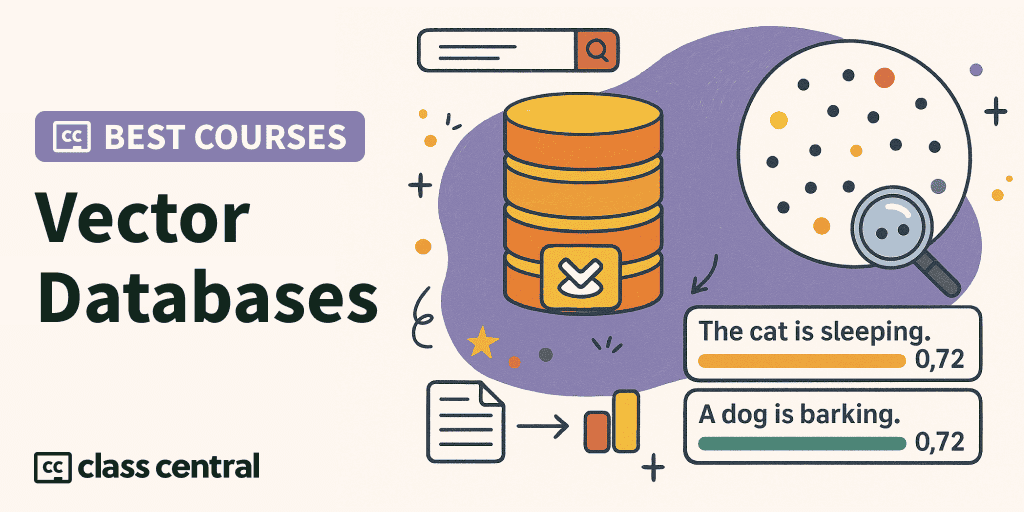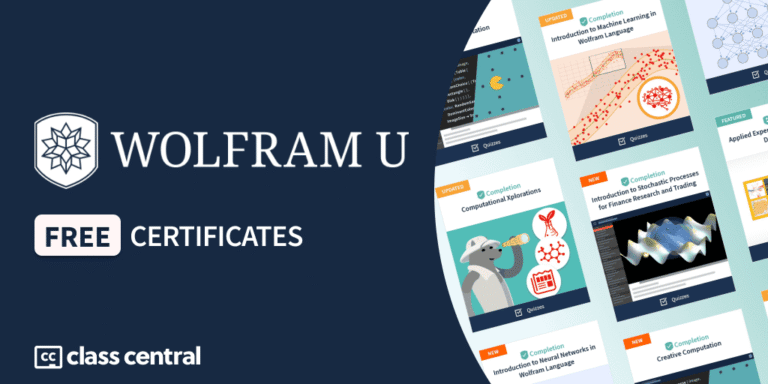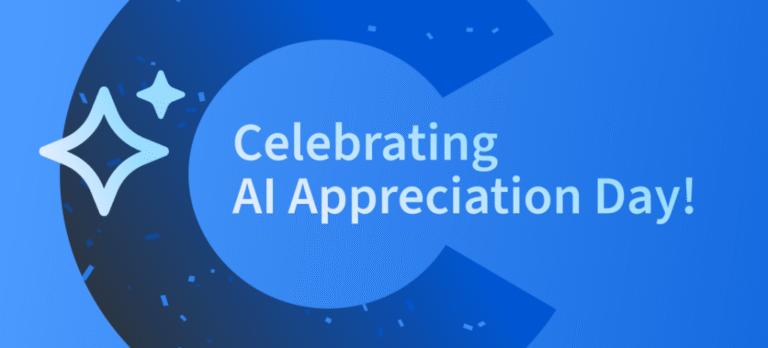

Picture this: You ask your favorite LLM about your company’s latest product and it responds with outdated or made-up information. Quite frustrating. This is where vector databases come in—they’re the technology that gives AI systems a searchable memory.
Whether you’re building the next killer RAG (Retrieval-Augmented Generation) application or creating a semantic search engine that understands what users mean, vector databases are the foundation along with embeddings to make it possible.
The rise of AI has created a demand for professionals who understand vector databases. With a quick search, you can confirm that employers are actively seeking professionals that can implement semantic search systems, build RAG pipelines, and manage vector embeddings at scale.
In this guide, we’ve analyzed dozens of courses across major platforms to bring you the best learning resources to master vector databases. Whether you’re an AI dev, a data scientist exploring semantic search, or an ML engineer building RAG systems, there is a course for you.
Click on the shortcuts for more details:
- Top Picks
- What is a Vector Database?
- Courses Overview
- Why You Should Trust Us
- How We Made Our Picks and Tested Them
Here are our top picks
Click to skip to the course details:
What is a Vector Database?
Think of a vector database as a specialized storage system that understands meaning, not just keywords. While traditional databases store and search for exact matches, vector databases work with numerical representations of data called embeddings—essentially converting words, images, or other content into lists of numbers that capture their semantic meaning.
Here’s a simple analogy: Imagine organizing music not alphabetically by artist name, but by the actual vibe, tempo, and style of songs. That’s what vector databases do with data—they organize information by meaning and context, allowing you to find similar items even if they don’t share exact keywords. When you search for “car,” you might also get results about “automobile,” “vehicle,” or even “Tesla” because the database understands these concepts are related.
Vector Databases vs. Embeddings: What’s the Difference?
It’s important to understand the distinction between embeddings and vector databases. Embeddings are the numerical representations themselves—the actual lists of numbers that encode meaning. A vector database is the infrastructure that stores, indexes, and enables efficient searching through millions or billions of these embeddings. You need both: embeddings to capture semantic meaning, and vector databases to make that meaning searchable at scale. Without a vector database, embeddings are just arrays of numbers sitting in memory; without embeddings, a vector database has nothing meaningful to search through.
Why are Vector Database Skills Important?
- Powering RAG pipelines: Vector databases are the backbone of RAG systems, allowing Large Language Models to access up-to-date, private, or specialized information beyond their training data
- Enabling True Semantic Search: Move beyond keyword matching to search systems that understand user intent and find conceptually similar content
- High Industry Demand: Companies across sectors—from e-commerce to healthcare—are implementing vector databases for recommendation engines, fraud detection, and intelligent search
- Career Opportunities: The research shows employers actively seeking professionals with hands-on experience in tools like Pinecone, Weaviate, and pgvector, with competitive salaries in the AI/ML space
- Foundation for AI Applications: Whether building chatbots, content recommendation systems, or multimodal search engines, vector databases are essential infrastructure
Courses Overview
- Combined, these courses have accrued over 500,000 enrollments across platforms
- 9 courses are featured from 4 different learning platforms
- Courses range from 1-hour quick introductions to comprehensive 4-week specializations
- Average rating of 4.6/5.0 across courses with available ratings
- Mix of free and paid options, with certificates available for most courses
Best Multimodal Vector Database Specialization (IBM)
This specialization on Coursera provides the most comprehensive introduction to vector databases across multiple technologies. The 4-course series is ideal for application developers, data scientists, and AI professionals who want thorough, hands-on experience.
What sets this specialization apart is its multi-database approach. Rather than focusing on a single vendor, you’ll work with Chroma DB, MongoDB, PostgreSQL (with pgvector), and Cassandra, giving you practical experience across different vector database paradigms. The curriculum emphasizes real-world applications, teaching you to create embeddings, build collections, perform similarity searches using cosine similarity, and culminates in a capstone project that incorporates RAG and LangChain.
In this specialization, you’ll learn:
- How to implement vector search in both NoSQL and relational databases
- Practical techniques for creating and managing embeddings across different systems
- Building AI recommendation systems using vector similarity
- Integrating vector databases with LangChain for RAG applications
- Best practices for choosing the right vector database for your use case
The specialization requires working knowledge of Node.js, RDBMS, and NoSQL databases.
| Provider | Coursera |
| Institution | IBM |
| Instructor | IBM Skills Network Team, Lavanya Thiruvali Sunderarajan, Richa Arora and Skill-Up EdTech Team |
| Workload | 40 hours |
| Enrollment | 1.7K |
| Rating | 4.3 |
| Cost | Free to audit |
| Quizzes/Assessment Items | Quizzes and Jupyter labs |
| Certificate | Available, paid |
Best Intro to Vector Databases with ChromaDB and Pinecone (Packt)
This course on Coursera strikes the perfect balance between conceptual understanding and hands-on practice. Despite being “intermediate,” it’s accessible to beginners with basic database and programming knowledge, making it an excellent starting point for those new to vector databases.
The course excels at explaining the fundamental differences between traditional and vector databases before diving into practical implementations. You’ll get hands-on experience with two popular vector databases—ChromaDB and Pinecone—learning not just how to use them, but when to choose one over the other. The coverage of vector similarity measures (cosine, Euclidean, dot product) provides the mathematical foundation needed to understand how semantic search actually works.
In this course, you’ll learn:
- Core differences between traditional databases and vector databases
- How to generate and work with embeddings for semantic search
- Hands-on implementation with ChromaDB and Pinecone
- Understanding and applying different similarity measures
- Integration techniques with Large Language Models
- Introduction to the LangChain framework for building AI applications
| Provider | Coursera |
| Institution | Packt |
| Workload | 8 hours |
| Cost | Paid |
| Quizzes/Assessment Items | Quizzes and code examples |
| Certificate | Available, paid |
Best Advanced AI Data Engineering Course with Qdrant (Pragmatic AI Labs)
This edX course is specifically designed for data engineers looking to add vector database expertise to their toolkit. Created by Pragmatic AI Labs and taught by industry veteran Noah Gift, it goes beyond basic usage to cover scalability and architectural considerations.
Module 3, “Achieving Scalability with Vector, Graph, and Key/Value Databases,” dedicates 5 hours specifically to vector databases. What makes this course unique is its focus on production-ready implementations, including working with Qdrant’s Rust client for high-performance applications. The course teaches you how to use vector databases and beyond that how to architect scalable solutions.
In this course, you’ll learn:
- Implementing semantic search at scale with proper architecture
- Qdrant quickstart and advanced usage with the Rust client
- Vector database architectural patterns for production systems
- Hands-on labs for enhancing semantic search performance
- Understanding the Jaccard index and other similarity metrics
- Integration with other database types in modern data stacks
The course includes 10 hands-on labs and requires basic AI/ML understanding along with Python proficiency. It’s particularly valuable for those who need to implement vector databases as part of larger data engineering pipelines.
| Provider | edX |
| Institution | Pragmatic AI Labs |
| Instructor | Alfredo Deza and Noah Gift |
| Workload | 12-24 hours |
| Cost | Free to audit |
| Quizzes/Assessment Items | Quizzes and labs |
| Certificate | Available, paid |
Best Vector Databases Overview (Packt)
If you want a comprehensive coverage of vector database principles in less than 5 hours, this course is for you. This course is particularly valuable if you need to make informed decisions about vector database selection for your projects.
The course systematically covers core concepts, starting with vectors, embeddings, and high-dimensional spaces before progressing to practical implementations. It covers multiple distance metrics (Euclidean, Manhattan, Cosine, Jaccard) and explains when to use each one. The real value comes from its comparative approach—you’ll work with demos of Pinecone, Qdrant, Milvus, and Weaviate, gaining insights into each platform’s strengths.
In this course, you’ll learn:
- Fundamental concepts of vectors, embeddings, and high-dimensional spaces
- KNN and ANN (Approximate Nearest Neighbor) search algorithms
- Comprehensive overview of indexing strategies: Flat Index, IVF, ANNOY, PQ, and HNSW
- Hands-on demos with Pinecone, Qdrant, Milvus, and Weaviate
- How to choose the right distance metric for your use case
- Performance trade-offs between different indexing approaches
The course requires basic understanding of databases and some familiarity with data structures and algorithms.
| Provider | Coursera |
| Institution | Packt |
| Workload | 8 hours |
| Cost | Paid |
| Quizzes/Assessment Items | Quizzes and code examples |
| Certificate | Available, paid |
Best NLP Foundations Course (DeepLearning.AI)
While not exclusively about vector databases, this specialization on Coursera provides crucial foundational knowledge for understanding how embeddings work. It’s particularly relevant for those who want to understand the “why” behind vector representations.
Course 1, Natural Language Processing with Classification and Vector Spaces, is the most pertinent to vector databases. It covers vector space models, which are fundamental to understanding how text is converted into the numerical representations stored in vector databases. The course also covers locality-sensitive hashing for approximate nearest neighbors—a key algorithm used in many vector database implementations.
In the whole specialization, you’ll learn:
- Fundamentals of vector space models and their applications
- How to implement logistic regression and Naive Bayes for text classification
- Principal Component Analysis (PCA) for dimensionality reduction
- Locality-sensitive hashing for efficient nearest neighbor search
- Word embeddings and their properties
- Building NLP applications that can be enhanced with vector databases
This specialization provides the theoretical foundations that makes subsequent vector database courses much easier to understand. It’s ideal for learners who want a deep understanding of the NLP concepts that underpin modern vector search systems.
| Provider | Coursera |
| Institution | DeepLearning.AI |
| Instructor | Eddy Shyu, Younes Bensouda Mourri and Łukasz Kaiser |
| Workload | 20 hours |
| Enrollment | 144K |
| Rating | 4.6 (5.7K) |
| Cost | Free to audit |
| Quizzes/Assessment Items | Jupyter labs |
| Certificate | Available, paid |
Best Quick Intro to Applications with Pinecone (DeepLearning.AI)
This 1-hour beginner course, taught by Tim Tully (Board member at Pinecone), is perfect for developers who want to quickly understand vector databases through practical examples.
The course’s strength lies in its project-based approach, walking you through six different applications that showcase the versatility of vector databases. From building a semantic search engine to implementing facial similarity search, you’ll see how vector databases solve real-world problems. The course uses Pinecone throughout, making it especially valuable if you’re considering this popular managed service.
In this course, you’ll learn:
- Building semantic search applications from scratch
- Implementing RAG systems with vector databases
- Creating recommendation engines using vector similarity
- Developing hybrid search that combines keywords and semantics
- Implementing facial similarity search for image applications
- Detecting anomalies using vector embeddings
- Best practices for production deployment with Pinecone
Despite its brevity, the course doesn’t sacrifice depth for speed. Each example includes working code that you can adapt for your own projects, making it an excellent starting point for developers who learn best by doing.
| Provider | Coursera |
| Institution | DeepLearning.AI |
| Instructor | Tim Tully (Board member at Pinecone) |
| Workload | 1 hour |
| Cost | Free |
| Quizzes/Assessment Items | Jupyter labs |
| Certificate | None |
Best for Semantic Search with Cohere (DeepLearning.AI)
This concise course bridges the gap between traditional keyword search and modern semantic search. It’s ideal for developers and data scientists who want to upgrade their search systems with semantic understanding.
The course effectively demonstrates the limitations of keyword search before introducing embeddings and dense retrieval. What makes it particularly valuable is its focus on the complete search pipeline—not just storing vectors, but also re-ranking results and generating answers with LLMs based on retrieved content. This end-to-end approach mirrors real-world implementations.
In this course, you’ll learn:
- The evolution from keyword search to semantic search
- How to generate and work with dense embeddings
- Implementing dense retrieval for better search results
- Re-ranking techniques to improve search relevance
- Integrating search results with LLMs for answer generation
- Practical implementation using Cohere’s embedding models
| Provider | DeepLearning |
| Instructor | Jay Alammar, and Luis Serrano |
| Workload | 1 hour |
| Cost | Free |
| Quizzes/Assessment Items | Jupyter labs |
| Certificate | None |
Best Vector Databases in Practice with Weaviate (LinkedIn Learning)
This LinkedIn Learning Professional Certificate, endorsed by Weaviate, offers over 4 hours of focused training on one of the most popular open-source vector databases. The two-course path is taught by Zain Hasan and JP Hwang (from Weaviate), providing both conceptual foundations and practical implementation skills.
The certificate path starts with “Introduction to AI-Native Vector Databases” before progressing to “Vector Databases in Practice: Deep Dive.” This structure ensures you understand the theory before diving into implementation. The code examples for building question-answering systems and the focus on creating search and recommendation applications make this a valuable resource for developers.
In this certificate program, you’ll learn:
- Foundational concepts of AI-native vector databases
- Building applications with Weaviate’s GraphQL API
- Implementing keyword, vector, and hybrid search strategies
- Creating recommendation systems powered by vector similarity
- Hands-on coding labs using Weaviate Python Client, Anaconda, Jupyter, and Docker
- Best practices for production deployment of Weaviate
| Provider | LinkedIn Learning |
| Instructor | Zain Hasan and JP Hwang (from Weaviate) |
| Workload | 4 hours |
| Enrollments | 9K |
| Ratings | 4.8 (150) |
| Cost | Paid |
| Quizzes/Assessment Items | Jupyter notebooks |
| Certificate | None |
Best Project-Based Vector Databases for Embeddings with Pinecone Course (DataCamp)
This DataCamp course offers hands-on practice with Pinecone, one of the most popular managed vector database services. This course is designed for data scientists who want practical experience building production-ready applications.
The course structure progresses logically from Pinecone fundamentals through to advanced applications. With 39 exercises, you’ll spend most of your time writing code rather than watching videos—ideal for those who learn by doing. The final project of building a RAG chatbot with OpenAI API provides a complete, deployable application you can showcase.
In this course, you’ll learn:
- Pinecone fundamentals: pods, indexes, and projects architecture
- Python client setup and database interaction patterns
- Creating, ingesting, querying, updating, and deleting vectors efficiently
- Performance tuning and multi-tenancy considerations
- Building a complete semantic search engine
- Implementing a RAG chatbot with OpenAI API integration
The course assumes Python proficiency but guides you through everything else.
| Provider | DataCamp |
| Instructor | James Chapman and Ryan Ong |
| Workload | 3 hours |
| Enrollments | 2.2K |
| Ratings | 4.8 (124) |
| Cost | Paid |
| Quizzes/Assessment Items | Interactive exercises |
| Certificate | None |
Why You Should Trust Us
Class Central, a Tripadvisor for online education, has helped 100 million learners find their next course. We’ve been combing through online education for more than a decade to aggregate a catalog of 250,000 online courses and 250,000 reviews written by our users. And we’re online learners ourselves: combined, the Class Central team has completed over 400 online courses, including online degrees.
For this guide, we’ve analyzed course content, instructor credentials, learner reviews, and practical applications to ensure our recommendations meet the high standards our readers expect. Our goal is to save you time by highlighting the courses that will actually help you build the skills employers are seeking.
How We Made Our Picks and Tested Them
To create this guide, we started with understanding what learners need to succeed with vector databases. We identified core challenges like grasping high-dimensional spaces, choosing appropriate indexing strategies, and implementing production-ready systems.
We evaluated courses based on several criteria: comprehensiveness of content, quality of hands-on exercises, instructor expertise, learner feedback, and relevance to current industry practices. We prioritized courses that balance theoretical understanding with practical implementation, knowing that employers value both.
Our selection spans different learning styles and objectives—from quick introductions for busy developers to comprehensive specializations for those seeking deep expertise. We included both free and paid options, ensuring quality learning is accessible regardless of budget. Where possible, we verified that courses stay current with the rapidly evolving vector database ecosystem.
Additional Resources and What’s Next
Your learning doesn’t stop with courses. The vector database community offers rich resources for continued growth. LangChain’s RAG From Scratch YouTube series provides a progressive understanding of RAG implementation. GitHub repositories like awesome-vector-database curate tools and resources, while write-you-a-vector-db teaches implementation from first principles.
Community forums on Reddit (r/Rag, r/vectordatabase) offer real-world problem-solving insights and tool recommendations. Many practitioners recommend starting with PostgreSQL’s pgvector if you know SQL, or ChromaDB for simple projects, before moving to specialized solutions.
Looking ahead, keep an eye on emerging trends: multimodal vector search combining text, images, and audio; improved indexing algorithms for billion-scale datasets; tighter integration with AI agents; and evaluation frameworks for RAG systems. The field is rapidly evolving—continuous learning through communities, documentation, and experimentation will keep your skills sharp.
Remember, mastery comes from building real projects. Start with a simple semantic search application, then progress to RAG systems. Each project will deepen your understanding and prepare you for the exciting challenges ahead in this transformative field.
The post 9 Best Vector Database Courses to Implement AI’s Searchable Memory appeared first on The Report by Class Central.













